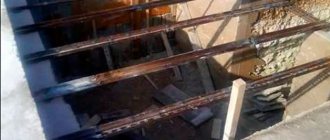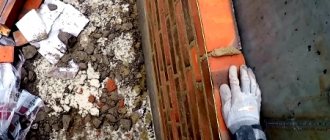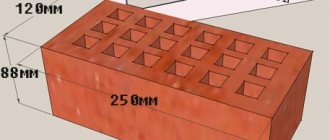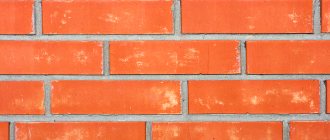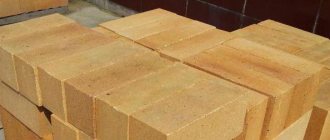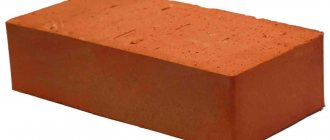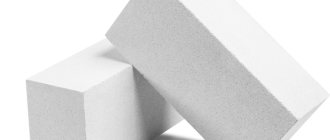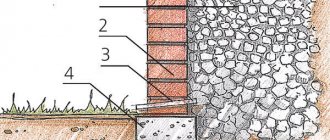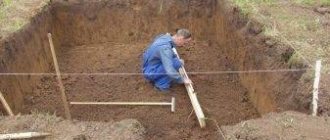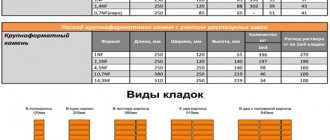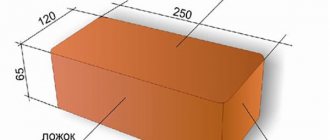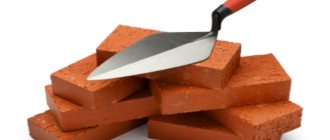Artificial stone is made by firing clay mixed with water; under the influence of temperature, irreversible chemical processes occur in it. When purchasing, you need to consider the quality, characteristics, type and size of red brick. After all, all these indicators can give the product various properties that affect its use.
Types, their characteristics and application
1. Solid red brick of classic size is used for the construction of load-bearing and reinforced structures, laying foundations, fireplaces, and stoves. It has grades M-075, M-100, M-125, M-150, M-175, frost resistance F 50, moisture absorption 8-10%, thermal conductivity 0.51 W/(mK), voids up to 13%. The size of a single red brick for building a house is 250x120x65 mm. Unit cost is from 9.40 to 16 rubles.
2. Fireproof - created specifically for lining and laying a furnace; its production requires fired refractory clay (fireclay) and fillers. It does not melt or crumble and can withstand temperatures up to 1800 degrees, has several classes: quartz, fireclay, basic, carbon. Letters and numbers in the marking indicate the level of fire resistance. The brand and size of red facing bricks can be different and depend on the physical and chemical composition; there are hundreds of types, for example: Sh-5, Sh-8, ShA-5, Shb-47. Frost resistance F 50-75, thermal conductivity from 0.70–0.85 W/(mK), voids from 8%, moisture absorption 8%. The average price per piece is from 20 rubles.
3. Red “loaf” brick, also known as solid backfill, double, weighs up to 7 kg. Stronger than the classic one, it is used for the construction of load-bearing walls, frames and supports. Has grades: 75, 100, 125, 150, 200, 250, 300, frost resistance F 150, moisture absorption 10%, thermal conductivity 0.50 W/(mK), voids up to 13%. The price for a “loaf” is from 10 rubles.
4. Red ceramic is used to lay the foundation. It must be durable and withstand temperature changes and humidity. Dimensions of a standard red brick for a foundation according to GOST: 250x120x65 mm, grades: 150, 175, 200, 250, 300, frost resistance F 50-100, moisture absorption 6-16%, thermal conductivity from 0.70 W/(mK), void ratio no more than 13 %. The average cost per unit is 11 rubles.
5. The red brick for the plinth must also be durable, resistant to moisture and cold. Use grades no lower than M-125 or M-150. Fired and solid ceramic is well suited for these purposes, but “Turtle” remains the leader. Its grades are M-200, M-250, M-300, frost resistance F 100, moisture absorption 12%, thermal conductivity 0.51 W/(mK), voids less than 13%. The unit cost is within 16 rubles.
When calculating estimates, it is important to take into account the dimensions of the artificial stone, the main ones are shown in the table:
When choosing, pay special attention to the quality; if chips and cracks, uneven coloring are visible, then it is better to refuse the product.
The size of the brick makes this material very convenient to work with. A wall made of compact building blocks can be easily erected with your own hands without the use of special equipment. Therefore, they are widely used by home craftsmen in the construction of buildings for various purposes.
Brick is by far the most popular building material. It is actively used both in the construction of private houses and in multi-storey construction.
It should be noted that multi-storey and block. The only drawback of such structures is the relatively high price of building materials and long construction times.
Characteristics of modern brick
Building bricks come in two varieties: red and white.
And before determining the size of the bricks needed to build the structure, you should decide on the material itself.
- Ceramic
. It is made using traditional technology, which involves firing the workpiece in a furnace under high temperatures. The raw materials for production are various types of clay, but red clay is most often used. From it, blanks (raw materials) are formed, which are fired in a kiln at a temperature of about 1000 degrees Celsius.
The photo shows a material with a full-bodied structure.
As a result, the material receives the following qualities:
- High strength and resistance to temperature changes. The ceramic block can withstand 100 cycles of temperature decreases and increases without loss of quality.
- Frost resistance.
- Excellent sound insulation, which has been duly appreciated in multi-storey construction.
- Easy to install. Most craftsmen do not require instructions to build a brick structure.
- High moisture resistance and low moisture absorption (only 8%), due to which the material dries very quickly.
- Heat resistance.
This building material has several disadvantages:
- Formation of efflorescence. Over time, white spots may appear on such masonry - efflorescence, which can ruin the appearance of the facade.
Advice! In order to avoid efflorescence, experts recommend using high grade cement when doing masonry.
- Quite a high cost, due to the difficulty of processing the material.
- If we are talking about a building block, then it does not contain dyes, and accordingly, the shade of the product depends entirely on the tone of the clay used. Therefore, building materials from different batches may have different colors. In this case, it is advisable to calculate in advance the required quantity per object, taking into account the dimensions of the modular brick.
- Silicate
- produced relatively recently, but these days it has become no less popular than its ceramic counterpart. They are produced using autoclave synthesis technology without using firing. The raw materials for production are quartz sand and air lime.
The material has the following advantages:
- It is more durable than ceramic.
- Not susceptible to efflorescence.
- Excellent sound insulator.
- Durable and environmentally friendly.
Disadvantages include low heat and water resistance.
Advice! Silicate material is not suitable for laying foundations, plinths, and cellars, since moisture destroys it. Also, fireplaces, stoves and chimneys should not be constructed from it, as it does not tolerate elevated temperatures.
Dimensions
GOST for brick sizes provides for three types of blocks: single, one-and-a-half and double. In this regard, construction and facing bricks have the same parameters.
Let's look at what sizes they have in more detail:
- Single. It has parameters of 250x120x65 mm. Brick sizes of 250 120 65 mm are considered optimal for the construction of buildings of any size and purpose.
- One and a half - corresponds to dimensions 250x120x88 mm.
- Double. It has parameters of 250x120x130 mm.
Advice! The use of a double block in construction can significantly speed up the construction process. This also reduces the cost of the construction itself by an average of 30%.
Dimensions of red and fireclay refractory bricks
For laying stoves and fireplaces, two main types of red brick are used, namely simple stove brick and refractory refractory brick.
- Red is rated for temperatures around 1000 degrees Celsius. Frost resistance is important for this material - especially for laying country stoves that are heated irregularly. Red Kiln Brick Size:
- length – 250;
- width – 120;
- height – 65 (mm).
Refractory fireproof must meet the following parameters:
Often, this type is used to cover the internal surfaces of fireboxes or entire rows of stoves that are subject to the most intense heating.
- Fireclay can withstand temperatures up to 1500 degrees. According to GOST, there are two main brands of bricks, ША and ШБ, their difference lies in the composition. The number in the marking indicates the overall dimensions. Mainly SHA:
- length – 230;
- width – 114;
- height – 60/65 (mm).
The stove brick has the standard dimensions of the stove brick. When lining the outside of the furnace, a ceramic type with fire resistance up to 1200 degrees is often used:
The fireclay look is suitable for the entire stove; its color and appearance make it possible not to use facing ceramic bricks to create a beautiful exterior.
- The most popular for building stoves is Vitebsk brick (GOST 530-95) with the following parameters:
- length – 250;
- width – 120;
- height – 65 (mm).
So, when choosing a material for the construction of stoves, you need to pay attention to its strength, size and weight, thermal conductivity, frost resistance and markings, which indicate the permissible load on the product.
The surface of this building material must be free of cracks and visible damage. Be sure to check it for emptiness inside - when you hit it with a hammer, the sound is not dull. The shape must also be correct, namely, all bricks must be the same size. Since this type is intended for laying in critical places, even the slightest defect is unacceptable here. If you choose the wrong material, the stove or fireplace will not be able to function normally. A good stove brick guarantees that your home will always be warm and comfortable.
In order for a fireplace or stove to have good draft, high thermal efficiency, as well as a reliable and durable design, none of the materials involved in the laying of this heating device should be neglected. Of particular importance is the choice of brick from which a fireplace or an ordinary home stove is laid.
We calculate building materials
Many home craftsmen are interested in how many pieces of bricks measuring 250 120 60 mm will be needed to build a house. Taking into account the size of ordinary bricks and the number of blocks that fit in 1 m2, you can easily calculate the required amount of products that will be needed for construction.
The instructions for carrying out the calculations are as follows:
- Determine the length of the external walls.
- We determine the surface area, taking into account the number of floors of the building.
- We determine the dimensions of the walls, taking into account the parameters of the building material.
- We determine the number of blocks required for construction work.
Let's look at the calculations using a specific example:
- So, we need to build a two-story house measuring 10 by 10 meters. The ceiling height in such a building will be 3 meters. First you need to determine the length of the external walls. In our case, they are equal, and therefore it is enough to multiply 10 by 4. We get 40 meters.
- Determine the area. To do this, multiply the total length by the height of the building. If the height of the ceilings in the house is three meters, and the number of floors is 2, then to find out the area, you need to multiply 40 by 6. We get 240 m2.
- Now you need to decide what size block will be used during construction. The dimensions of ordinary bricks fully satisfy the requirements for the walls of a two-story building. However, for additional strength we will use double sand-lime brick M 150. By the way, the size of the M 150 brick is used in the construction of multi-story buildings, which once again proves its high strength.
A masonry of 2.5 blocks will be enough to obtain strong and reliable structures. In this case, the load-bearing wall, 2 bricks thick, will be built from double blocks, and the cladding will use single blocks.
- Now, having decided on all the parameters of the future house, we can calculate the amount of building materials. To do this, multiply 240 (the area of the external walls) by the brick consumption per 1 m2 (data are given below).
- We determine the required quantity of double silicate block: 240×104 = 24960 pieces.
- Quantity required for M100 brick: 240×51=12240 pieces.
Consumption rate of building materials per 1 m2 depending on the width of the masonry
The information below will help you with your calculations. These are the consumption rates for blocks of various sizes per 1m2, taking into account the masonry mortar:
- Half-block masonry:
- Single – 51 pieces.
- One and a half - 39 pieces.
- Double – 26 pieces.
- When making masonry with a thickness of 1 block:
- Single – 102 pieces.
- One and a half - 78.
- Double – 52.
- One and a half masonry:
- Single – 153.
- One and a half - 117.
- Double – 78.
- Double masonry:
- Single – 204 pieces.
- One and a half – 156.
- Double – 104.
- Laying 2.5 bricks:
- Single – 255.
- One and a half - 195.
- Double – 130.
Cement consumption during wall construction
- Cement consumption does not depend on the type of masonry. The main criteria here are: the dimensions of the block and the thickness of the structure.
Advice! For the construction of load-bearing walls, it is necessary to use cement of a higher grade than for the construction of self-supporting partitions.
- If we talk about cement consumption, taking into account the size of an ordinary brick, then 1 m2 of brickwork will require an average of 0.2 m3 of mortar. The consumption of the solution increases in direct proportion to the dimensions of the block, so it is easy to calculate the amount of cement, knowing their consumption per 1 m2 of masonry.
Using Kiln Bricks
There are details in the furnace business, ignoring which inevitably leads to deep disappointment with the results of your work. Let's draw your attention to them.
Masonry mortar
Ordinary cement mortar is unacceptable in kiln construction. You will need a mixture of pure dark red or brown clay (Cambrian is ideal), water, and sand. Tips on how to make an excellent solution yourself can be found in a separate article. For beginners, it is better not to take risks and purchase a ready-made mixture of cement with reinforcing heat-resistant fibers that is resistant to flame and moisture.
Read more about preparing mortar for laying a stove.
Secrets of the right planter
The maximum seam thickness is 5 mm. For fireclay it is even smaller - 2-3 mm.
Any furnace model is built in accordance with a strict sequential scheme. It is customary to fold the first rows dry for testing and check the accuracy of the placement. Start with the corners, checking that they are horizontal and square. If everything is smooth and correct, finishing masonry begins. The bricks are not stacked on top of each other, but a certain order of alternating their positions is observed. This prevents delamination of the structure and evenly distributes the load on each of the rows.
An ideal option for external walls, when the middle of another brick is located above the seam. On the façade, a decorative quarter bandage is acceptable. To make the task easier, chopped material is actively used: quarters, halves, three-quarters.
Features of masonry in the cold season
Those who did not have time to build a home in the summer do not have to postpone work until spring. It can also be done in winter, if the room is not frozen to sub-zero temperatures. A gas or heat gun will help raise the temperature to the required minimum of 10 degrees Celsius.
All bricks, as well as the prepared mortar, must be heated before use. You cannot bring material in from the cold and immediately lay it down.
Construction of a pipe on a snow-covered roof in frosty weather is especially problematic. It is necessary to clean its surface and create reliable scaffolding. Adding salt to the mixing water (1 kg per 10 liters) will make the solution suitable for laying at sub-zero temperatures. A brick smokehouse is erected subject to the creation of an insulating fence on the roof in the form of a polyethylene booth. You can move away from the classics and install an insulated metal sandwich pipe.
The structure is thoroughly dried before receiving the working load:
- in a natural way (if it is possible to maintain the required thermal conditions).
- gradual heating (starting with wood chips, moving to more and more firewood and then to coal).
List of common mistakes
In the process of gaining experience, most craftsmen commit similar violations of construction technology:
- They work with dry bricks, ignoring the need to soak them and rinse them with water. The thickness of the seams increases, and reliability and durability decrease.
- Narrowing the cross-section of the smoke channel below the minimum of one brick per 300 square meter die. cm. Traction is noticeably reduced.
- Installation of the fire door frame tightly, without a thermal gap (0.5–1 cm) and laying asbestos cord or filling with mortar.
- Lack of other necessary thermal clearances.
- Incorrect wire binding made deeper than 2 cm from the outer walls of the oven.
- Installation of vertical internal partitions on metal supports instead of bricks placed at the end.
- Laying the outer part of the chimney using clay mortar instead of cement.
- The location of the oven is close to the combustion chamber.
Building a home yourself is a job for the patient and attentive. But it is quite within the power of a man who is used to achieving his goal. Stock up on knowledge, basic materials and get to work. We wish you success!
About hollow and solid material
Regardless of the size of the brick according to GOST, solid and hollow blocks are distinguished. The structure of the first of them is a monolithic block with an extremely small presence of voids (no more than 13%). It is often called "loaf".
Hollow has on average about 35% voids, expressed in the form of edges, recesses, through and non-through holes.
The differences between solid and hollow blocks are as follows:
- The solid one is stronger, therefore it is used in loaded structures.
- The hollow one is lighter and therefore does not require a powerful foundation. Due to the presence of voids, such a material has a greater heat capacity.
Story
Depending on the state, the dimensions of the masonry material differed significantly. This was due primarily to differences in metric systems. For example, the brick standard in England in the 19th century had dimensions of 9: 4.5: 2.5 inches, German material - 25: 12: 6.3 centimeters.
On the American continent it had the smallest dimensions
, which were 21:10:5.3 centimeters. In the Russian Empire, the material was larger than its English or German counterparts, and amounted to 6:3:1.5 (4.45 centimeters). He weighed about three to four kilograms.
Territories remote from the center themselves determined the dimensions of the building material, which sometimes differed from the “canonical” ones, since production was not dependent on the center and the material was used to meet the needs of local communities.
With the advent of conveyor production of building materials and the beginning of mass capital construction, the need to fix the dimensions of standard red brick became more acute.
In European countries, the most common bricks are NF and DF brands. The first is ordinary, with dimensions of 24 × 11.5 × 7.1 cm, the other is thin, with dimensions of 5 × 5.2 centimeters.
In Europe, DF brand material is considered the best for perception
, thanks to greater compliance with architectural classics. But the NF brand saves mortar and increases the speed of masonry construction.
This aspect ratio of the brick not only turned out to be the most optimal when constructing a wall, when it is necessary to alternate the longitudinal and transverse positions of the bars, but also to use material from different manufacturing plants on one construction site.
Surprisingly, in Russia, bricks of a unified standard began to be produced relatively recently, compared to how long this material has been used in the country - in 1927. Since then the standard has remained unchanged
- 250×120×65 millimeters for a single brick size, its weight should be no more than 4.3 kg and all this is fixed by GOST 530−2007. In Europe, it is designated by the symbols RF with parameters of 250×120×88 millimeters for one and a half bricks (although in practice it is not 1.5, but 1.35 times thicker) and 250×120×138 mm for double bricks.
In Western countries, the standards are different, and there are many more of them. Among the most popular are 200×100×50 (65) millimeters and 240×115×52 (71) millimeters. In addition to the above, foreign bricks can be of different sizes
, since in Europe there is an opinion that masonry made of material with a non-fixed length can emphasize the uniqueness of the building.
Fireclay brick
It is most often used in domestic buildings, although it is often used in the construction of industrial facilities.
This heat-resistant brick owes its name to a special material - fireclay, which is produced from white kaolin clay in rotary or shaft kilns by firing at very high temperatures (about 1400-1500⁰C). Therefore, such products can be used at high temperatures and remain neutral to chemical, acid and other influences. This type of alumina brick can have different shades.
Features of the production of fireclay bricks for furnaces greatly influence its price. And therefore, in order to reduce the cost of the stove, such products are usually used when laying the combustion chamber and some elements of the chimney system.
Main characteristics
Fireclay bricks are different:
- high fire resistance;
- the ability to accumulate and release thermal energy;
- high porosity, which is ensured by the presence of aluminum oxide in it.
By the way, the latter quality determines the long heating and the same cooling of the stone.
Important! The percentage of thermal conductivity of a brick is inversely proportional to its mass. That is, the greater the mass of the stone, the lower the thermal conductivity.
Therefore, when purchasing, you should pay special attention to this quality.
Regular fireclay bricks are produced in sizes 250x120x65 mm. Due to the increasing pace of construction and demand for products, the production of shortened and elongated blocks, as well as bricks of various volumes and configurations, has now been launched.
Thanks to the wide range of colors of products, more and more consumers are buying fireclay bricks for laying stoves and do not use facing or clinker tiles at all.
Quartz
If the clay mass used to produce refractory bricks for the furnace needs to be reinforced with large grains of quartz, graphite or coke powders, then after burning, the result will be a brick with different properties, respectively, of different types: quartz and carbon.
Quartz, like its carbon counterpart, belongs to the red refractory brick. It is used to construct vaults in reverberatory furnaces. In addition, it is used to construct the walls of furnaces, which in the future will only come into contact with metals or fire.
Clay is used to cement such products, which gives the fired product incredible strength.
Carbon
If you press clay together with coke or graphite, you get a high-quality carbon-type refractory brick. But such stones are not used for domestic purposes, but only in industrial production. For example, without them it is impossible to build an open-hearth furnace or a blast furnace.
The importance of standardization
The normal dimensions of the brick are in the ratio 1:½:1/4, which makes it possible to give the building structure additional strength using masonry ligation. This happens due to the fact that longitudinal and transverse alternation of building material is carried out
in relation to the axis of the masonry and, as a result, the load is more evenly distributed.
In addition to the above, the proportionality that is present in the standard brick size allows masonry work to be carried out with low labor costs. The briquette lifts easily and can be held with one hand.
Also, the size of a standard window when building a brick house is much more convenient to determine based on the standardization of the dimensions of the material.
Types of bricks, their characteristics and areas of use
Full-bodied
Regular-sized bricks are used for the construction of load-bearing and reinforced structures, laying foundations, fireplaces, and stoves. There are brands designated as M-075, M-100, M-125, in addition, there is M-150, M-175, frost resistance level F 50, degree of moisture absorption 8-10 percent, thermal conductivity parameters 0.51 W/( m/K), void ratio up to 13 percent.
Refractory
This brick is intended directly for cladding and laying stoves. For its production, baked refractory clay
(called fireclay) and various fillers. It does not melt or crumble and can withstand heat levels up to 1800 degrees Celsius. Letters and numbers in the marking indicate the level of fire resistance. The brand and size of such material can be different and depend on the composition; there are a large number of types, for example: Sh-5, Sh-8, ShA-5, there is also ShB-47. Frost resistance level F 50−75, heat conductivity from 0.70−0.85 W/(m/K), void ratio from 8 percent, degree of moisture absorption 8 percent.
Red
It is also called “loaf”, full-bodied butt or double and it weighs up to 7 kg. The strength is higher than the classic one, and it is used to build load-bearing structures, frames, etc. There are brands: 75, 100, 125, 150, 200, 250, 300 are also available for sale, frost resistance level F 150, moisture absorption ability 10 percent, thermal conductivity parameters 0.50 W/(m/K), void ratio up to 13 percent.
Ceramic
Red ceramic bricks are used to lay the foundation. It requires strength, the ability to withstand temperature changes and high humidity. Dimensions according to GOST standards 250×120×65 mm, brands sold: 150, 175, 200, 250, 300, frost resistance level F 50−100, degree of moisture absorption 6−16 percent, thermal conductivity parameters from 0.70 W/(m/K ), the void ratio is no more than 13 percent.
For the construction of a basement
This brick must also be strong enough and resistant to moisture and low temperatures. It is best to use brands of at least M-125 or M-150. For such purposes, fired and solid ceramic may be optimal.
, but the most popular remains “Turtle”. The following brands are on sale: M-200, M-250, M-300, frost resistance level F 100, degree of moisture absorption 12 percent, thermal conductivity parameters 0.51 W/(m/K), void ratio less than 13 percent.
Fire brick
You can build a stove entirely from fireclay bricks, but due to its considerable cost, such a unit will cost its owner a substantial amount. It is more advisable to use refractory bricks for laying the main part of the stove and the smoke exhaust duct. It is made by firing a mixture consisting mostly of red fire clay and some quartz sand.
Scheme for the production of refractory bricks.
The most important characteristic of this type is resistance to temperatures up to 1000 °C. In addition, it has sufficient heat capacity, so a stove made of such material releases heat for a long time.
Today, refractory material is available in two sizes:
Often, refractory bricks are used to line a smoke exhaust duct from a metal pipe. On the one hand, such a chimney is resistant to aggressive chemicals (acid-resistant steel is used), on the other hand, it has good thermal insulation and high heat capacity.
Bricks of this variety can be red or brown.
Return to contents
What material is required to build a furnace?
Sometimes red solid ceramic stone can be confused with real stove brick. It is produced by mixing red and blue clay, adding sand, and then firing the mass. It can withstand temperatures of no more than 800 degrees Celsius, so the walls of the stoves will quickly collapse (wood burning occurs at 900 degrees Celsius).
There are four types of real stove bricks:
- the main one is a mixture of lime and magnesia, mostly used in metallurgy;
- quartz - sandstone, quartz, with the addition of red dense clay;
- carbon - made of pressed coke, intended for the construction of blast furnaces;
- fireclay is a fireproof material, it consists of 70 percent fireclay, is universal in use, and resistant to chemical influences.
Types of bricks for stove masonry
Let's start with the main thing - fire-resistant bricks. That's what it's called - stove. There are 4 varieties of it:
- Quartz. This type of material is made by firing a mixture consisting mainly of quartz sand and a small amount of clay. The disadvantage of quartz brick is its instability to acids and other aggressive chemicals, upon contact with which it quickly collapses.
- Carbon. The raw material for this variety is coke or graphite, which is pressed under high pressure. Carbon brick is used to construct a domain.
- Basic. This type of building material is widely used in the metallurgical industry. It is made on the basis of a lime-magnesite mixture.
- Fireclay (alumina). The mixture from which alumina brick is made consists of 70% of a special type of clay called fireclay. It is to her that this material owes its fire-resistant properties. Fireclay bricks are used to make fireboxes for household stoves and fireplaces, so we will talk about it in more detail later.
Return to contents
Kiln brick size according to GOST
A separate document has not been developed for bricks specifically for stoves
, there is only GOST 8426–75, which specifies the size and shape of clay bricks for chimneys. According to the established standard, there are 2 sizes of regular straight bricks, listed below:
- single - dimensions 250×120×65 millimeters;
- thickened - dimensions 250×120×88 millimeters.
Also, according to GOST 8426–75, wedge-shaped bricks of 2 types are produced.
- Radial-longitudinal. There are also single (dimensions 120 (70)x250×65; 120 (100)x250×65) and thickened (dimensions 120 (70)x250×88; 120 (100)x250×88).
- Radial-transverse. The single standard size is available in 2 dimensions: 250 (200)x120×65; 250 (225)x120x65. And the thickened standard size, instead of 65 mm, has a size of 88 mm.
Bricks for the construction of fireclay stoves, existing shapes and sizes
To make installation easier, furnaces produce products that differ in configuration and dimensional parameters.
- this can be seen from the table below.
The standard size of the kiln brick is the blade. It, like straight types, is produced in the shape of a parallelepiped. The largest edge is called a bed, the medium-sized one is called a spoon, and the smallest edge is called a poke. The butt is narrowed in the end wedge, and the spoon is narrowed in the rib wedge. These two varieties are used for figured masonry. In addition to standard products, fireclay slabs can be found on sale
- their dimensions correspond to the size of the firebox they need to cover. The most common bars of these dimensions are 460×230×75 millimeters; there is also a dimension of 600×230×90 millimeters.
Due to the ability to accumulate heat well, fireclay bricks can be recommended not only for the construction of fireboxes, but also for the entire structure of the furnace as a whole. This solution will be interesting in decorative terms, because the straw-golden color of the clay products will create a visual effect of warmth in the room. The many shapes and sizes that fireclay stove bricks have make it possible to lay out not only standard straight ones, but also vaulted ones; trapezoidal surfaces are also possible.
It is important to know the size of the brick, at least so that during the construction process you do not have to fuss with excess material or, conversely, buy more. The publication's experts bring you up to date: how to figure out the size of a brick if the mysterious markings don't tell you anything even after talking with a consultant.
Requirements for the size of red bricks for the stove
Red brick is made from red clay. Stoves and fireplaces are built from it. There are 2 types of it: simple oven and refractory refractory.
A simple brick can heat up to 1000 °C. More often, it is used to make stoves in country houses, which are used inconsistently. The red stove version has a standard size:
- Length – 250 mm;
- Width – 120 mm;
- Height – 65 mm.
Refractory fireproof has the same length and height, differs only in width (123 mm). Suitable for lining the internal surfaces of fireboxes or individual areas of the furnace with the highest heating.
The fireclay version can be heated up to 1500 °C; it has the ability to retain heat for a long time. According to GOST, there are 2 brands: ShA and ShB. In this case, the number reflects the dimensions.
As was said at the beginning, it is this type that is most suitable for laying stoves and fireplaces in homes. Plus, it has a winning color. Its golden shades create a feeling of additional comfort in the house, which allows you to do without ceramic facing material for the stove.
When choosing a brick, pay attention not only to the main characteristics indicated in the marking, such as size and thermal conductivity, but also to the external condition. Check that the products are of the correct shape and the same size; they should not have any chips, cracks or other defects. It’s also a good idea to tap it with a hammer to eliminate any voids inside the building material.
Source: setafi.com
Brick size: scope of application of different types
Scope of application:
- laying the foundation;
- construction of walls (load-bearing, including);
- construction of basement floors;
- façade cladding;
- construction of brick partitions;
- construction of stairs;
- laying fireplaces and stoves;
- arrangement of basements.
The main groups of bricks, depending on the material of manufacture:
- white silicate;
- ordinary red;
- facing;
- ceramic.
Ordinary ordinary brick differs from facing brick:
- structure;
- frost resistance and moisture resistance;
- appearance;
- at a price.
The geometric dimensions of the brick are also very important. When alternating transverse and longitudinal stones, thanks to these parameters, masonry can be done rationally, taking into account the need for dressing.
Brick size standard:
- single;
- one and a half;
- double;
- eurobrick;
- modular.
By form:
- hollow (slotted);
- full-bodied;
- porous.
The dimensions of a standard brick are determined based on the type of brick. The main parameters are (according to GOST):
- width;
- height;
- length.
How many bricks are needed for 1 m2 of masonry is determined by the usual calculation, taking these dimensions as a basis. When determining how many bricks are in a cube (1m3) (according to GOST), the dimensions of the working brick should be 25 cm (length), 12 cm (width), 6 cm (height). According to calculation: single bricks - 513, one-and-a-half bricks - 379, double bricks - 242.
Note that the dimensions of single and one-and-a-half bricks differ by 23 mm, but in weight they (if solid) are almost the same.
The bricks produced are classified according to certain grades. This concept implies the strength of the brick to load and deformation, as well as frost resistance. Today, according to GOST, eight strength grades are known from M50, M75 to M200, M250, M300.
Clinker bricks are produced with strengths of both M500 and M1000. The most popular are M100, M125, M150. M100 is considered ideal for the construction of a private house, and M150 for a high-rise house. Also, a single brick is marked by size - 1-NF, double - 2-NF.
During production, different technologies are used, focusing on territorial features, therefore the types and sizes, its characteristics and technical indicators will differ from each other.
The following indicators are considered:
- thickness;
- dimensions;
- thermal conductivity;
- thermotechnical features.
Brick color
Obviously, the color of the future house directly depends on the color of the brick. Depending on the clay used in the manufacture, the brick can be white, yellow, or red. The most popular is red brick.
IMPORTANT! In addition to ordinary single bricks with dimensions of 250x120x65 mm, thickened bricks (one and a half) with dimensions of 250x120x88 mm are also used. It features a wider butt edge, but the length and width remain identical.
Masonry bricks have unusual names for the sides: the small one is “poke”, the large one is “bed”, the middle one is “spoon”.
Characteristics of ceramic material
The main difference in the production of ceramic bricks is the use of such types of clay, which during the firing process acquires a unique unique shade.
A stone created artificially from mineral raw materials, having strength, moisture and heat resistance and receiving these properties during firing, is called brick.
The stove masonry can be made from solid ceramic bricks and using stove bricks. Ordinary sand-lime bricks are placed on the roof.
Unfortunately, it often happens that red solid ceramic bricks are issued behind the stove. To make it, blue and red clay is used, mixed with sand and fired. It is able to withstand temperatures of 700-800 degrees. But in practice, the use of this type leads to the rapid destruction of furnaces. Therefore, calling a ceramic brick a stove brick means misleading a potential buyer.
What kind of work can be done with ceramic bricks? These are various decorative elements of the stove, smoke circulation, you can put the outer walls of the stoves. Ceramic bricks are divided into two groups: front and non-face. The front one is usually installed during the construction of fireplaces; it can be figured. This type of brick usually has a three-sided chamfer. Not the front one is placed in the stove bases. It may have a heterogeneous structure, fluctuations in size, and there may be swelling.
Solid ceramic bricks are marked with the letter “M” and numbers that indicate the load per 1 sq.cm. To lay out a stove or fireplace, brick grade M-150 and higher is used.
Types of bricks offered
Type/characteristics (use)
| Model | Description |
| It is divided into: solid, used for laying walls of buildings, pillars, columns, laying chimneys and stoves; hollow, which is used for constructing partitions, filling frames, and additional external walls; facing (“front”, “facade”), which is used for cladding buildings. | |
| The speed of laying is ensured by protrusions on one side and rounded recesses and recesses on the reverse. Used for the construction of partitions, load-bearing walls, cladding, masonry of decorative columns and support pillars. | |
| It is divided into types: porous, thermally efficient, cement-sand, ceramic, diatomite foam. Hollow is used for load-bearing walls and internal partitions. There are different block sizes. One-and-a-half slotted ones are suitable for main walls, single slotted ones are suitable for lightweight construction, and double slotted ones are indispensable for large-scale construction. | |
| Brick loaf | Produced by a brick factory in Makhachkala. Characteristics: red, double, full-bodied, backfill, weight up to 7 kg. Used in the construction of frames, load-bearing walls, supports, dimensions - 250x120x65 mm. |
| Attention is paid to the following parameters: bricks must be of the same shape and size; surface – smooth, without chips or cracks; the color is rich and uniform. Typically, full-bodied red is used for the base, which may be burnt. Used: clinker, acid-resistant ceramic, red clay, silicate. | |
| For external decoration of buildings, narrow facing is used. The application is purely decorative. Often used for finishing small objects, for example, interior wall cladding and fireplaces. | |
| English is presented in yellow, red-brown, black and blue, and can be variegated or uniform. The old method of producing handmade bricks (available at IBSTOCK factories) is based on hammering a lump of clay directly into a wooden mold. Usually used for finishing work. | |
| Italian can be whole or half (there is also a spil). Stylish and refined in appearance, it allows for masonry with displacement of elements to different depths. | |
| Rough (worker, ordinary) is used for the construction of partitions and walls that require subsequent plastering, putty, painting or cladding. Used for the construction of basements and foundations. | |
| Used to build walls. | |
| Used to create an original interior. Ideal for laying window and door openings, circular and bay windows, for all structures with arched elements, including arches. | |
| Clay, chopped straw, water and additives that regulate mechanical properties are used for production. Area of application: southern regions with a hot and dry climate. Often used in rural areas when constructing outbuildings. | |
| For the construction of partitions in buildings, hollow or porous ones are used. | |
| Refers to a finishing building material, used for decorating architectural elements of building facades, internal cladding works, and street barriers. Features - the presence of a cut on one of the corners. | |
| The tile is elongated in shape, reminiscent of a brick, the chamfers (facets) are beveled, which gives a convex appearance. It is used as a finishing material for loggias, bathrooms, public spaces - beauty salons, restaurants, cafes. | |
| In the form of backfill (rubble) brick there is a red ceramic stone, the appearance of which has disadvantages, namely: chips, roughness, oblique edges, heterogeneity of texture and color. Used as a simple working material. | |
| Scope of application of torn stone: cladding of fireplaces, facades, plinths, pillars and other surfaces. It is made by decorative pecking (one of the sides), which protrudes the front side and gives it a torn texture. | |
| The method for producing ceramic red brick is firing clay at high temperatures with the addition of plasticizers and fixatives of natural origin. This is the most environmentally friendly and warm material. Used in the construction of residential buildings. | |
| Able to withstand the effects of acids. Used in industrial enterprises to protect equipment in contact with aggressive substances. They are used in the construction of gas ducts, chimneys, gutters, towers, and tanks. | |
| They are used in the construction of cottage and multi-storey houses, gazebos, arches, fences, for interior decoration, and in the reconstruction of small architectural forms and buildings. There are 23 colors. | |
| Fireproof (heat resistant) | Used for the construction of objects that are maximally exposed to elevated temperatures or open fire (fireplaces, chimneys). There are: fireclay, carbon, quartz, basic. The weight of fireclay is heavier than that of construction, with the same dimensions. The most famous manufacturer is Vitebsk. |
| Used for the construction of furnaces. Types: oven red and oven face. | |
| Refers to fireproof. It is used in the construction of melting pots and furnaces in civil, residential and industrial construction. Withstands ultra-high temperatures over 1000°C. | |
| An excellent decorative facing stone, developed using vibration pressing technology. Available in a wide range of colors. For its production, elite grades of cement, plasticizers, and fine sifted sand are used. | |
| For façade cladding, a facing cladding is used, subdivided into: clinker, ceramic, silicate; hyperpressed (concrete). | |
| Brick-ceramic building blocks. Suitable for different types of wall laying in one row or more: main and non-main, external and internal, filling spaces between walls, laying partitions. |
- Advantages of block bricks over conventional ones:
- ease of operation due to the large dimensions of the blocks;
- strength;
- fire resistance;
- environmental friendliness;
- coefficient of thermal conductivity;
- flexibility in finishing and decoration.
- Aerated concrete:
- durability;
- low thermal conductivity coefficient;
- environmental friendliness;
- high fire resistance;
- efficiency.
- Cinder block:
- inexpensive to purchase;
- speed of laying;
- strength.
- Foam concrete:
- efficiency;
- comfort at home;
- high heat and sound insulation properties.
- Gas silicate:
- construction is possible without further insulation;
- high environmental friendliness;
- strength;
- good sound insulation;
- low cost.
- Available in blocks:
- thermal insulation;
- thermal insulation and structural;
- structural.
- Brick is also offered:
- size 250x120x60 mm made of soapstone;
- size 250x120x38 mm - Kashira construction slotted brick;
- 190x90x70 mm - decorative modular, gives the facade of the house a “techno-style”.
IMPORTANT! Soapstone is a rock formed from soft minerals. This is a polished stone that resembles marble.
Red (ceramic) brick size
Sand-lime brick size
Dimensions of facing bricks
Characteristics according to GOST
| Dimensions | Type | View |
| 250x120x65 mm | Standard | Yellow |
| 250x120x60 mm | Single | Yellow |
| 250x120x103 mm | One and a half | Yellow |
| 250x120x65 mm | Single | White |
| 250x120x90 mm | One and a half | White |
| 250x120x65 mm | Single | For facade |
| 250x120x88 mm | One and a half | For facade |
| 250x120x138 mm | Double | For facade |
| 210x100x50 mm | Single | |
| 240x115x52 mm | Single | Custom size brick |
| 210x100x65 mm | Single | Custom size brick |
| 240x115x71 mm | One and a half, clinker | |
| 250x60x65 mm | American standard, ceramic | |
| 250x85x65 mm | Euro | |
| 250x88x85 mm | Euro |
Ceramic brick size
Fireclay brick size
Solid brick size
Hollow brick dimensions
Specifications
| Dimensions | View | Manufacturers |
| 250x120x88 mm | One and a half | Brick |
| 250x120x140 mm | Double | |
| 250x85x65 mm | Euro | Brick |
| 288x138x65 mm | Modular single | Brick factories - Stary Oskol, Khabarovsk |
| 250x200x70 mm | Ceramic | Brick factories - Stary Oskol, Khabarovsk |
| 250x120x88 mm | White silicate hollow | Brick |
| from 250x120x140 mm to 260x510x219 mm | Large large format ceramic blocks | Brick factories - Stary Oskol, Khabarovsk |
Despite the “magical” name, this brick has no connections with Christmas. The brick got its name thanks to the place of production - the Rozhdestvensky brick factory, which is located in the southern city of Stavropol. Like many southern enterprises producing building ceramics, Rozhdestvensky KZ, Stavropol, produces high-quality products from high-grade clay raw materials.
It’s worth noting right away that, unlike many brick factories that focus on producing one or two types of bricks, the choice of Rozhdestvensky KZ fell not on ordinary solid bricks, but on double bricks.
Using old bricks
Layout of brickwork. There are two main methods of bricklaying: with single-row (chain) and multi-row ligation of seams.
The question often arises: is it possible to lay used bricks? It is quite possible to lay bricks in the future furnace that were located in chimneys, ceiling cutting, and in the first rows. They must be thoroughly cleaned of soot and solution. The smoky side should be laid inside the masonry, as traces of soot can appear in the form of rusty spots through the plaster and whitewash. And your new stove will look unpresentable.
But bricks that previously experienced high temperatures in the firebox cannot be reused!
A high-quality stove is not only the right stove brick, but also the choice of good clay. It is divided into fatty, medium and skinny. If the clay is oily, the sand ratio is 1:10 or 1:8, in medium clay the ratio is 1:8 or 1:3, in lean clay there is more sand than 1:3.
Determining the quality of clay is quite simple. Roll it into a sausage as thick as your finger. If the sausage bends and does not break, and does not crack when drying, you have fatty clay. If the sausage breaks and cracks when it dries, you have medium clay. It is difficult to form a sausage out of thin clay, but if you succeed, it crumbles when it dries.
The oven requires the use of oily and medium clay. It is very good if you add fireclay powder to the clay solution. you will purchase it in the same place where fireclay (alumina) material is sold.
I would like to emphasize once again that a stove in the house is not only warmth and comfort, but also an increased fire hazard. Therefore, when constructing it, it is important not only to accurately follow the laying technology, but also to use high-quality materials.
Double brick
also known as ceramic block or ceramic stone. Recently, this “grade” of building ceramics has become increasingly popular. This trend can be explained by the fact that modern construction is characterized by increasingly high rates and limited deadlines. It is clear from this that developers prefer to choose the most efficient building materials. One of these is ceramic stone.
Request a call right now and get detailed advice on Christmas bricks
